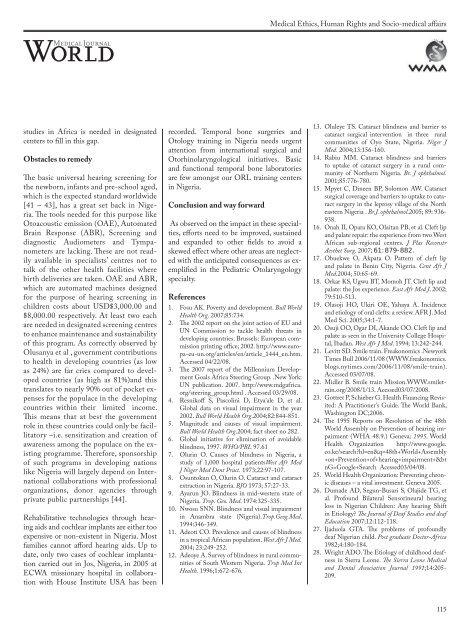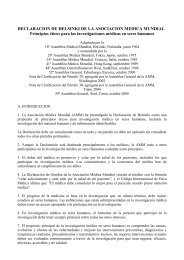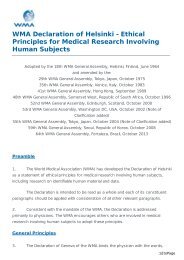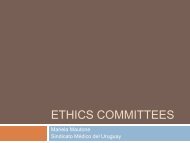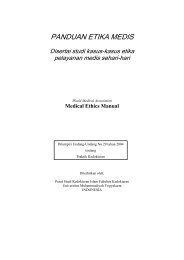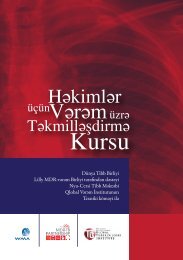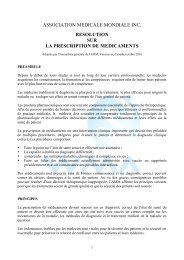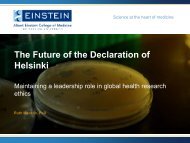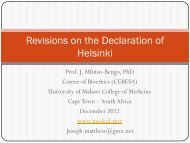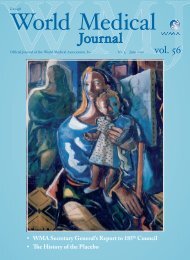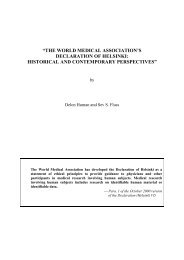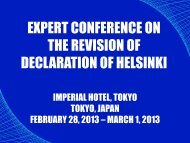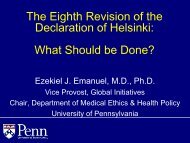wma 7-2.indd - World Medical Association
wma 7-2.indd - World Medical Association
wma 7-2.indd - World Medical Association
Create successful ePaper yourself
Turn your PDF publications into a flip-book with our unique Google optimized e-Paper software.
<strong>Medical</strong> Ethics, Human Rights and Socio-medical affairs<br />
studies in Africa is needed in designated<br />
centers to fill in this gap.<br />
Obstacles to remedy<br />
The basic universal hearing screening for<br />
the newborn, infants and pre-school aged,<br />
which is the expected standard worldwide<br />
[41 – 43], has a great set back in Nigeria.<br />
The tools needed for this purpose like<br />
Otoacoustic emission (OAE), Automated<br />
Brain Response (ABR), Screening and<br />
diagnostic Audiometers and Tympanometers<br />
are lacking. These are not readily<br />
available in specialists’ centres not to<br />
talk of the other health facilities where<br />
birth deliveries are taken. OAE and ABR,<br />
which are automated machines designed<br />
for the purpose of hearing screening in<br />
children costs about USD$3,000.00 and<br />
$8,000.00 respectively. At least two each<br />
are needed in designated screening centres<br />
to enhance maintenance and sustainability<br />
of this program. As correctly observed by<br />
Olusanya et al , government contributions<br />
to health in developing countries (as low<br />
as 24%) are far cries compared to developed<br />
countries (as high as 81%)and this<br />
translates to nearly 90% out of pocket expenses<br />
for the populace in the developing<br />
countries within their limited income.<br />
This means that at best the government<br />
role in these countries could only be facillitatory<br />
–i.e. sensitization and creation of<br />
awareness among the populace on the existing<br />
programme. Therefore, sponsorship<br />
of such programs in developing nations<br />
like Nigeria will largely depend on International<br />
collaborations with professional<br />
organizations, donor agencies through<br />
private public partnerships [44].<br />
Rehabilitative technologies through hearing<br />
aids and cochlear implants are either too<br />
expensive or non-existent in Nigeria. Most<br />
families cannot afford hearing aids. Up to<br />
date, only two cases of cochlear implantation<br />
carried out in Jos, Nigeria, in 2005 at<br />
ECWA missionary hospital in collaboration<br />
with House Institute USA has been<br />
recorded. Temporal bone surgeries and<br />
Otology training in Nigeria needs urgent<br />
attention from international surgical and<br />
Otorhinolaryngological initiatives. Basic<br />
and functional temporal bone laboratories<br />
are few amongst our ORL training centers<br />
in Nigeria.<br />
Conclusion and way forward<br />
As observed on the impact in these specialties,<br />
efforts need to be improved, sustained<br />
and expanded to other fields to avoid a<br />
skewed effect where other areas are neglected<br />
with the anticipated consequences as exemplified<br />
in the Pediatric Otolaryngology<br />
specialty.<br />
References<br />
1. Fosu AK. Poverty and development. Bull <strong>World</strong><br />
Health Org. 2007;85:734.<br />
2. The 2002 report on the joint action of EU and<br />
UN Commission to tackle health threats in<br />
developing countries. Brussels: European commission<br />
printing office; 2002. http://www.europa-eu-un.org/articles/en/article_1444_en.htm.<br />
Accessed 04/22/08.<br />
3. The 2007 report of the Millennium Development<br />
Goals Africa Steering Group. .New York:<br />
UN publication. 2007. http://www.mdgafrica.<br />
org/steering_group.html . Accessed 03/29/08.<br />
4. Resnikoff S, Pascolini D, Etya’ale D, et al.<br />
Global data on visual impairment in the year<br />
2002. Bull <strong>World</strong> Health Org.2004;82:844-851.<br />
5. Magnitude and causes of visual impairment.<br />
Bull <strong>World</strong> Health Org.2004; fact sheet no 282.<br />
6. Global initiative for elimination of avoidable<br />
blindness, 1997. WHO/PBL 97.61<br />
7. Olurin O. Causes of blindness in Nigeria, a<br />
study of 1,000 hospital patientsWest Afr Med<br />
J Niger Med Dent Pract. 1973;22:97-107.<br />
8. Osuntokun O, Olurin O. Cataract and cataract<br />
extraction in Nigeria. BJO 1973; 57:27-33.<br />
9. Ayarun JO. Blindness in mid-western state of<br />
Nigeria. Trop. Geo. Med. 1974:325-335.<br />
10. Nwosu SNN. Blindness and visual impairment<br />
in Anambra state (Nigeria).Trop.Geog.Med.<br />
1994:346-349.<br />
11. Adeoti CO. Prevalence and causes of blindness<br />
in a tropical African population. West Afr J Med.<br />
2004; 23:249-252.<br />
12. Adeoye A. Survey of blindness in rural communities<br />
of South Western Nigeria. Trop Med Int<br />
Health. 1996;1:672-676.<br />
13. Oluleye TS. Cataract blindness and barrier to<br />
cataract surgical intervention in three rural<br />
communities of Oyo State, Nigeria. Niger J<br />
Med. 2004;13:156-160.<br />
14. Rabiu MM. Cataract blindness and barriers<br />
to uptake of cataract surgery in a rural community<br />
of Northern Nigeria. Br. J ophthalmol.<br />
2001;85:776-780.<br />
15. Mpyet C, Dineen BP, Solomon AW. Cataract<br />
surgical coverage and barriers to uptake to cataract<br />
surgery in the leprosy village of the North<br />
eastern Nigeria . Br.J. ophthalmol.2005; 89: 936-<br />
938.<br />
16. Onah II, Opara KO, Olaitan PB, et al. Cleft lip<br />
and palate repair: the experience from two West<br />
African sub-regional centres. J Plas Reconstr<br />
Aesthet Surg. 2007;61:879-882.<br />
17. Obuekwe O, Akpata O. Pattern of cleft lip<br />
and palate in Benin City, Nigeria. Cent Afr J<br />
Med.2004; 50:65-69.<br />
18. Orkar KS, Ugwu BT, Momoh JT. Cleft lip and<br />
palate: the Jos experience. East Afr Med J. 2002;<br />
79:510-513.<br />
19. Olasoji HO, Ukiri OE, Yahaya A. Incidence<br />
and etiology of oral clefts: a review. AFR J. Med<br />
Med Sci. 2005;34:1-7.<br />
20. Osuji OO, Ogar DI, Akande OO. Cleft lip and<br />
palate as seen in the University College Hospital,<br />
Ibadan. West Afr J Med. 1994; 13:242-244.<br />
21. Levitt SD. Smile train. Freakonomics .Newyork<br />
Times Bull 2006/11/08 (WWW.freakonomics.<br />
blogs.nytimes.com/2006/11/08/smile-train).<br />
Accessed 03/07/08.<br />
22. Midler B. Smile train Mission.WWW.smiletrain.org/2008/1/13.<br />
Acessed03/07/2008.<br />
23. Gottret P, Schieber G. Health Financing Revisited:<br />
A Practitioner's Guide. The <strong>World</strong> Bank,<br />
Washington DC;2006.<br />
24. The 1995 Reports on Resolution of the 48th<br />
<strong>World</strong> Assembly on Prevention of hearing impairment<br />
(WHA 48.9.) Geneva; 1995. <strong>World</strong><br />
Health Organization http://www.google.<br />
co.ke/search?hl=en&q=48th+<strong>World</strong>+Assembly<br />
+on+Prevention+of+hearing+impairment+&bt<br />
nG=Google+Search Acessed03/04/08.<br />
25. <strong>World</strong> Health Organization: Preventing chronic<br />
diseases – a vital investment. Geneva 2005.<br />
26. Dumade AD, Segun-Busari S, Olajide TG, et<br />
al. Profound Bilateral Sensorineural hearing<br />
loss in Nigerian Children: Any hearing Shift<br />
in Etiology? The Journal of Deaf Studies and deaf<br />
Education 2007;12:112-118.<br />
27. Ijaduola GTA. The problems of profoundly<br />
deaf Nigerian child. Post graduate Doctor-Africa<br />
1982;4:180-184.<br />
28. Wright ADO. The Etiology of childhood deafness<br />
in Sierra Leone. The Sierra Leone <strong>Medical</strong><br />
and Dental <strong>Association</strong> Journal 1991;14:205-<br />
209.<br />
115


